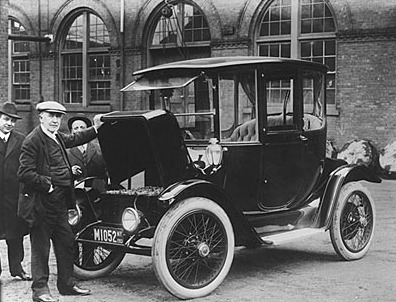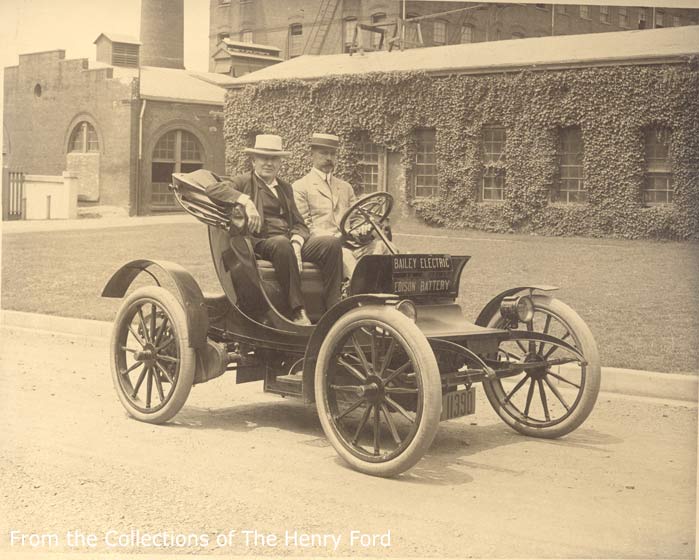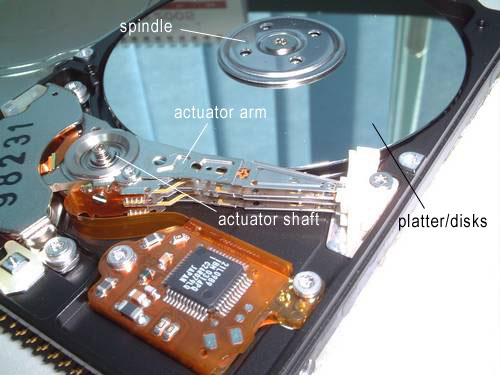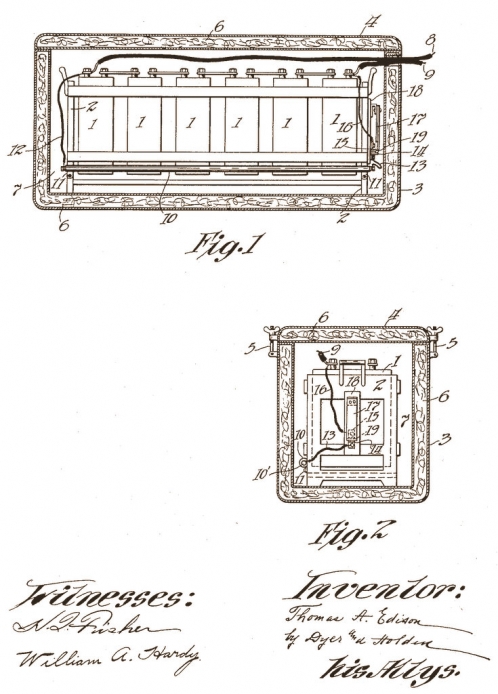
News, Reviews, Interviews and Overviews of all things related to EEStor Inc.
Monday, August 31, 2009
The Thomas Edison EEStor-like Battery Mystery

Major Nanosolar News scheduled for Sept 9, 2009 or The September 9, 2009 Announcement Page

Followers of the EEStory know I'm not entirely one dimensional. I do track other technologies and one of them is solar printing mystery company Nanosolar. As I do periodically, I shot a note to Martin Roscheisen this morning requesting an interview. Within 4 minutes, I had a reply saying he would allow the interview in the 2nd half of September and that there is
Friday, August 28, 2009
The Significance of Polarity to the EEStor Equation
 I've had some time to digest the recent discovery that Polarity has publicly announced it's supplier relationship with EEStor and ZMC. My potentially shocking conclusion is that unlike any other partner that has been discovered and at least in one major way, Polarity adds the most credibility to EEStor. More than Mort Topfer. More than Kleiner Perkins. And yes, more than Lockheed Martin. Why? Quite simply because the stakes are much higher for a smaller firm like Polarity for whom a significant portion of their revenue is based on Military contracts. I believe Polarity is gambling much more than any of these other entities who can easily take risks to reputation on projects like EEStor's. Not so with Polarity for whom, at this stage in their development, reputation is everything. To take a credibility hit by associating with a fringe science entity just does not wash with maintaining much less growing a business performing services for the Military. Note the Secret Clearance they maintain on their facility. Familiarize yourself with the process to obtain such a designation (you'll probably get an untrusted certificate). I'm not saying every government action is rational. I'm simply saying it's highly unlikely that anyone wishing to grow a business in that environment would take unnecessary risks to reputation. Have a look at this excerpt from the facility clearance FAQ:
I've had some time to digest the recent discovery that Polarity has publicly announced it's supplier relationship with EEStor and ZMC. My potentially shocking conclusion is that unlike any other partner that has been discovered and at least in one major way, Polarity adds the most credibility to EEStor. More than Mort Topfer. More than Kleiner Perkins. And yes, more than Lockheed Martin. Why? Quite simply because the stakes are much higher for a smaller firm like Polarity for whom a significant portion of their revenue is based on Military contracts. I believe Polarity is gambling much more than any of these other entities who can easily take risks to reputation on projects like EEStor's. Not so with Polarity for whom, at this stage in their development, reputation is everything. To take a credibility hit by associating with a fringe science entity just does not wash with maintaining much less growing a business performing services for the Military. Note the Secret Clearance they maintain on their facility. Familiarize yourself with the process to obtain such a designation (you'll probably get an untrusted certificate). I'm not saying every government action is rational. I'm simply saying it's highly unlikely that anyone wishing to grow a business in that environment would take unnecessary risks to reputation. Have a look at this excerpt from the facility clearance FAQ:"4. HOW DOES A FACILITY BECOME ELIGIBLE TO BE CONSIDERED FOR A CLASSIFIED BID OR QUOTATION?
A: The same process used in the case of an unclassified procurement is involved. The facility must qualify as a bidder to a Government procurement activity or to a prime contractor or subcontractor performing on a Government contract. If the bid or potential subcontract involves access to classified information, the procuring activity or cleared prime contractor submits a request to clear the prospective bidder. Personnel from the Facility Clearance Branch at Defense Industrial Security Clearance Office (DISCO) evaluate the request and assure that the request is valid. Part of this validation includes confirmation that the facility has a reputation for integrity and lawful conduct in its business dealings. Further, the contractor and its key managers must not be in a “barred” status from participating in Government contracts."
Additionally, they seem pretty capable of keeping secrets as I've attempted on two occasions to obtain an interview. On both occasions I was referred to EEStor. I also asked ZMC for comment and was pointed back to Polarity and/or EEStor. EEStor had no comment.
On an unrelated note: a Washington Post poll reveals most people support President Obama's handling of Energy policy...even the idea of cap n trade! Not so sure about that myself.
Wednesday, August 26, 2009
A New Storage Battery
He Has Found, He Says, Long Sought Qualities of Lightness and Durability
It's not difficult to imagine the above article title and subtitles announcing yet another introductory article on the topic of EEStor Inc. But what if I told you, you could replace the name Weir with Edison and have the beginnings of a New York times article written 108 years ago on a new battery Thomas Edison had invented? Mildly interesting? What if I told you that at the time of the writing the properties of the new battery were already "long sought after" and considered as revolutionary as the "incandescent light." Not bad, you say? Sit down, there's more....much much more.

On May 23, 1901, a New York Times article was published covering the reading of a paper at an annual meeting of the American Institute of Electrical Engineers. The reader, A.J. Kennelly announced the invention of a new battery by Thomas Edison and described all of it's advantages in comparison to the existing batteries of the day (which were lead acid believe it or not): not only would Edison's battery be two to three times lighter and more durable, it would charge in 3.5hrs instead of the standard 7.5 to 8 hrs of it's competitors. They would also work better in cold weather. Yes, but what about capacity you ask? Remarkably, an example given over a century ago was that of the range of an automobile (No, I'm not making this up). At the time, the longest known distance a battery powered vehicle had traveled was 50 miles. It was claimed that Edison's new battery would double that range to 100 miles. (Hello, GM Volt crazies).

Not surprisingly, the other applications for Edison's new battery were transportation related. The New York Times report read:
"The advantages of the new invention as set forth by an engineer are so comprehensive that it was predicted that a new art of electrical propulsion and navigation would result. Among the possibilities is a new electric street car, the doing away with the present trolley system, and the substitution of a car supplied with power by storage battery. Likewise, owing to durability and to the cheapening of the batteries and the facility of their mechanism, it is predicted that electric light will be cheapened and that electric power in time may supersede that of steam in many factories now dependent upon the steam boiler. "

If you're a regular at TheEEStory.com and you are experiencing a strange little feeling you can't put your finger on, consider this. The century old article states that Edison's battery was "passed the experimental stage and has been tested and proved in actual practice to such an extend that a factory is about to be built to manufacture the batteries for commercial purposes." According to the article, Edison made the claim that his battery was "theoretically indestructible" because in tests they had charged it in reverse and restored it to full capacity with a regular charge. This should sound similar to Richard Weir's claims about the indestructibility of the EESU -- and how it will outlast the equipment to which it is attached -- with component parts of the EESU having been apparently tested (charged/discharged) to more than a million cycles. And if that is not similar enough to EEStor, the reporter also captured some stealth with Edison having "declined to discuss the commercial advantages of the new invention beyond saying that he had purchased the old Hayden Mill in Genridge, about two miles from West Orange, where he will take immediate possession and begin at once the manufacture of the new batteries."
The reporter added, "He said he would organize the Edison Storage Battery Company and would retain absolute control of the business. "
Unlike the reception EEStor has received from their electric industry peers, Edison received immediate praise from the the Electrical Review:
"Mr Edison has produced no invention of broader utility in the electrical field since incandescent lighting was evolved from the busy brain of the same pioneer of industry. It is hard to foresee all the meaning of this improvement. But we may look a little way and see the noiseless city, the suppression of the horse, and the automobile a factor of economic importance in general transportation. The perfected battery means the solution of many difficult traction problems, the betterment of electric lighting, and the foundation of the new art of electric navigation. Electric tugboats will give new life to our canals, and with electric ferryboats will revolutionize our harbors. Electric torpedo-boats of swiftness and secrecy will make present naval armaments of doubtful protection."

Military silent applications? Check. Noiseless cities? Check. Renewable energy. Check. A difficult to predict but certain revolutionary impact? Check, check, check. Edison's battery advance was the EEStory of his day. But he had the credibility of the light bulb under his belt, an invention so much less complicated than the data storage disk technologies invented by Nelson and Weir a decade ago when they created a hard disk able to spin at 50,000 RPM's which could survive a disk crash of the arm into the platter, a capability still not commercially available (after all, if disks didn't fail, how would Seagate or Western Digital sell more of them?)
 Thomas Edison c. 1912.
Thomas Edison c. 1912.As for Edison, at the time of the New York Times article, he was only willing to say the following:
"I have concerned myself almost solely with the improvement of the new battery for at least a year. I began the experiments that have led up to the invention a number of years ago. Ever since last August I have confined myself exclusively to the new battery, trying it out in practice under all sorts of conditions of temperature and road traffic--for the batteries have been tried on heavy work. I have always been more interested in the solution of the problem of furnishing a power to do the useful and heavy work rather than to provide means for pleasure vehicles, and it is in the direction of heavy trucking especially that I expect the new battery will work a revolution."
Over the next several years, Edison went on to slowly introduce his battery into various applications as he predicted. According to The Edison Papers, a Rutgers Univ project, the battery became Edison's most successful project in later life.

But in 1911, 10yrs after making his initial statements about the battery, Edison was finally prepared to make a real EEStor-caliber claim. At a national convention of electric power companies, Edison was asked about his battery business. Quoting again from a New York Times article (this one dated June 11, 1911):
"I have done far better than that now, and nothing has come out about it. I have perfected a battery which can be recharged in three or four minutes and which will run fifty or sixty miles without being recharged. The trouble with the first battery was that the recharging took a long time. When charged a car would run all day, but then it took the better part of the night to recharge it and get it ready for the next day. But I have done away with all that. I have now a battery which can be put into a suit case, it is so small and light, and it can run a car, truck automobile, or vehicle of any kind until the power is used up and then recharged in less than 3 minutes, ready for service as before."
Apparently, this script has played out once before a hundred years ago. So what happened to all of this great Edison battery technology? First, some of Edison's batteries did in fact display a certain measure of indestructibility having remained functional over 70 years! This lead to the battery being known as "too good" since it could outlast some of the equipment it was intended to power, which from a manufacturing point of view is economically unattractive. In 1960, the Edison Battery Storage business division was sold to the company now known as Exide Technologies, a company which claims to be nothing less than the largest and most global maker of....cover your ears.......lead acid batteries. Perform a keyword search for 'Edison' on their website and you will get no hits. The nickel-iron chemistry Edison based his battery on is actually still in use in China among other places, perhaps because they are far less toxic than their lead acid counterparts. Incidently, Exide Technologies was awarded $34Mil to advance lead acid batteries in the recent DOE advanced battery stimulus funding. (They spent $60K on lobbying in 2009 and some of their execs have made several donations to the Republican National Committee. )

So if the batteries did in fact perform as Edison described, how come we have never heard of the quick charge claim attributed to him by the New York Times article? To find out, I contacted leading scholars familiar with the history of electric vehicles and Thomas Edison. I pointed out the article where the claim was documented and hoped for a quick solution. The answer is that it is unknown but worthy of further investigation. HHhhmm. That sounds familiar. :-)
Note: I will not be starting a website devoted to the quest to uncover the truth about the Edison quick charge battery. :-) But I challenge you to solve it!
Many Images Courtesy of National Park Service.
Tuesday, August 25, 2009
Supplier Announces EEStor Contract in support of Zenn Motor Company

At some point recently, EEStor supplier Polarity Inc., announced via it's website a contract with EEStor Inc. In its entirety, the terse release says:
2009 Awarded contract from EESTOR to integrate Polarity’s high power HV to LV converter into EESTOR's EESU that will be used in Zenn Motor Company’s small to medium size electric car
The converter in question is further described on Polarity's Products page:
Polarity designed this HVLV600 DC to DC converter with the following specifications:
- Input Voltage - 3700VDC to 700VDC
- Output voltage and current - 600VDC, 17A
- Maximum Output Power - 10KW
- Short circuit proof
- Effeciency > 90%
- Cooling - Maximum base plate temp 60C
Monitoring and control
- Battery charge complete
- Battery voltage
- Buss voltage
- Inhibit
- Up conversion enable
- Down conversion enable
- Overload
- External 12VDC power supply

Polarity has also had a patent publish in Aug 2008 at WIPO.
Story Source. Thx Paulnessss
Monday, August 24, 2009
Boston Power Article in Boston Globe: No DOE Funds
Friday, August 14, 2009
Titanium X Memory Lane
 I caught up with Dr. Wilbur C. Krussell today on the phone and had a chance to talk with him about his 2&1/2yrs working with Dick Weir and Carl Nelson at Titanium X. What does he remember about them?
I caught up with Dr. Wilbur C. Krussell today on the phone and had a chance to talk with him about his 2&1/2yrs working with Dick Weir and Carl Nelson at Titanium X. What does he remember about them? Thursday, August 13, 2009
Regarding EEStor & DOE Funding
 There's been a bit of head scratching concerning whether or not EEStor ever applied for federal funding and if not, why not. Without attempting to resolve all those questions at once, it was pointed out to me that EEStor has what can fairly be described as pretty good counsel on the matter. Observe. I'm referring to Wilson Sonsini Goodrich & Rosati's Clean tech practice which maintains a competency with important regulatory developments in the space. Their clients include Tesla, Smith Electric Vehicles, Proterra (the electric bus people), Bloom Energy, and energy storage firms Imara & ActaCell.
There's been a bit of head scratching concerning whether or not EEStor ever applied for federal funding and if not, why not. Without attempting to resolve all those questions at once, it was pointed out to me that EEStor has what can fairly be described as pretty good counsel on the matter. Observe. I'm referring to Wilson Sonsini Goodrich & Rosati's Clean tech practice which maintains a competency with important regulatory developments in the space. Their clients include Tesla, Smith Electric Vehicles, Proterra (the electric bus people), Bloom Energy, and energy storage firms Imara & ActaCell. Government Initiatives. We recognize that
successful navigation of government policy
and funding programs can be critical to the
success of many of our clean technology and
renewable energy clients. With this in mind,
our government initiatives team focuses on
providing clients with critical information
regarding legislative and regulatory
developments, as well as an understanding of
the processes that companies must follow to
obtain government funding for their clean
technology ventures and renewable energy
projects. Our attorneys work closely with
clients on submissions for loan guarantees,
grants, and other federal funding programs
and give strategic advice on best practices in
managing these complex processes.
Wednesday, August 12, 2009
Kleiner Partner Bill Joy Heads EEStor Relationship

According to a very well connected anonymous source, Bill Joy is the Kleiner Perkins partner who initiated the EEStor Inc. investment. Additionally, he is responsible for having recruited Mort Topfer to serve on the EEStor Board of Directors.
In the past, this has been a question relegated to rumor....(still will be for some. )But for me, I am highly confident it is the case based on a highly credible source who simply preferred not to be quoted. Joy co-founded Sun with recent EEStor commentator Vinod Khosla and a gaggle of other legendary nerds.
One of the challenges in seeking a comment from Kleiner Perkins on EEStor is trying to target the correct partner to talk about it. Knowing that Joy handled the EEStor investment at least makes that part of the puzzle easier to handle. To date, I've requested comments from Kleiner on most of EEStor's announcements and news items. But they have said that if an investment is not listed on their website, they do not comment on it. On another occasion, a spokesperson for Kleiner told me that they do not comment on investment companies if the company receiving the investment asks them to do so.
image source: wikimedia.org
Tuesday, August 11, 2009
Mort Topfer Continues to Retire
Saturday, August 8, 2009
NY Times Article on Batteries
I'm not saying anything is amiss for certain. But, it seems good journalism practices would at least lead one to inquire into some of these issues. It just feels like ever since the Obama administration began, all the tough questions have been set aside.
Wednesday, August 5, 2009
Another EEStor Skeptic Takes a Swipe
In the meantime, in the absense of this confirmation, I'll simply restate my position: I believe EEStor has exactly what they claim and will deliver it as they promise. Everyone wants a time frame but I don't think that is quite as important. And skeptics have a point here regarding timeframes that, again, can't be ignored. But for me, based on all the information I have had the opportunity examine, I think EEStor has done it.
One final thing about John Peterson. I reached out to him via email a few weeks back because I learned he sat on a panel at Storageweek with a Kleiner partner. Did the Kleiner partner mention EEStor? No. Did Peterson ask? No. This brings me to rule #1 of anyone who would attempt to get to the truth about EEStor: when you get the opportunity to ask someone who owns 20% of EEStor a question about their prospects, you ask the question. :-)
Monday, August 3, 2009
Why would DARPA fund EEStor? Businessweek Article Provides Insights

Steve LeVine has written about some of new cleantech priorities of DARPA in this July 23, 2009 article as well as points about past achievements. A few months back, I tried unsuccessfully to speak with Robert J. Nowak, who is mentioned in this article. He has been involved with multiple energy storage initiatives for the DoD and someone who served on a National Academies committee with him recommended I seek him out. Alas, LeVine had better luck. Steve, if you read this blog post, shoot my email address over to Mr. Nowak: eestorblog@gmail.com
From the article:
"Typically, DARPA requires contractors to come up with solutions that are orders of magnitude superior to current technology. It pays companies—from startups to IBM—as well as top universities to meet a goal. Then, other than imposing strict reporting requirements, the agency gets out of the way of the researchers' work."

